




By Aria Binns-Zager Staff Writer
he front lawn of the Minnesota State Capitol pulsed with chants, banners, and unwavering resolve on April 5 as thousands assembled for the “HANDS OFF” rally — a powerful rebuke of rising police aggression, the tightening grip of surveillance, and the continued systemic neglect faced by Black, brown, and Indigenous communities.
The cold didn’t stop them. Neither did the threat of rain.
And though the sky hung heavy and gray, the message rang bright and clear: Hands off our bodies. Hands off our families. Hands off our communities. Hands off our future.
More than a demonstration, the rally was a communal
heartbeat — a convergence of resistance, memory and hope brought together by a coalition of grassroots justice organizations. Activists, artists, elders, students, and everyday Minnesotans stood shoulder to shoulder, united in their demand for a government that prioritizes people over profit, care over punishment, justice over silence.
“We’re not political people, we’re just people,” said Tonya M., a home care worker from Brooklyn Park, balancing her toddler on one hip and a handmade sign on the other. “But when the decisions made in D.C. make it harder for me to feed my child, I show up.”
From my chats with attendees, some of the concerns fueling attendance were: rent is sky-high, classrooms are ■ See HANDS OFF on page 5

By Jasmine McBride
Associate Editor
n a historic move, Minnesota officially launched the nation’s first “Missing and Murdered Black Women and Girls Office” during a ceremony at the State Capitol on April 9.
The office, which aims to address the disproportionately high rates of violence faced by Black wom-
en and girls, was celebrated with the inaugural “Missing and Murdered Black Women and Girls Day on the Hill.”
The event brought together hundreds of advocates, lawmakers, and community members to honor the lives lost and to call for continued action.
The creation of the office follows years of advocacy from families of victims and grass-

roots organizations working to shine a light on the oftenoverlooked crisis of missing and murdered Black women and girls.
Director Kaleena Burkes, appointed in 2024, emphasized the significance of the office “guiding women and girls who deserve to be protected, women and girls whose names should have never become headlines or cold cases. We hold them in our hearts, and we carry their stories forward, not as statistics, but as lives that matter.”
She further highlighted the systemic issues contributing to the crisis, noting that Black women and girls often face a lack of urgency and media coverage when they go missing, attributing this to factors like adultification and dehumanization.
“Minnesota has done something remarkable. This state
■ See MINNESOTA on page 5
Aria Binns-Zager Staff Writer
esearchers across the United States are quietly changing how they apply for federal grants, omitting terms such as “Black,” “women,” “marginalized” and “trauma” in an effort to avoid rejection, according to multiple academic sources and internal documents.
At the center of the controversy is the National Science Foundation (NSF), a major federal research funding agency. Internal NSF materials reviewed by The Washington Post, along with whistleblower accounts and academic testimony, indicate that the agency is flagging proposals that include language commonly associated with diversity, equity and inclusion (DEI).
The flagged terms reportedly include “advocacy,” “un-

derrepresented,” “gender,” and “female.” Proposals that include such language may be routed to additional manual review, where they could be revised or denied, the report found.
The NSF declined to comment on the matter when contacted.
According to the internal documentation, the NSF uses automated tools to scan for
DEI-related terms in proposals. Applications identified through this process are subject to further scrutiny to ensure compliance with executive orders issued during the Trump administration, which remain in effect. Those orders did not explicitly ban DEI-related language, but researchers and
By Jasmine McBride Associate Editor
uanell Mims, a beloved matriarch and lifelong advocate for St. Paul’s historic Rondo neighborhood, was honored April 10 by Mayor Melvin Carter and Ramsey County leaders with proclamations celebrating her 94th birthday and her extraordinary contributions to the community. The following day, friends, family, and community members gathered at Flava Café to celebrate Mims’ legacy with music, memories, and heartfelt tributes.
Born in Oklahoma, Mims migrated to St. Paul in 1953 during the Great Migration. She and her late husband, David Mims, settled in the Rondo neighborhood in 1954, where she would become an enduring figure of love, strength and resilience for generations.
“Miss Mims has been a pillar of our community for generations,” said Mayor Carter. “Her story reflects the resilience,
strength and spirit that define the Rondo neighborhood and the city of St. Paul.” Mims worked for 25 years

at Sears, where she broke barriers as the first Black department manager in St. Paul. She was also a choir director at Mount Olivet Missionary Baptist Church, a board member of Gospel Choirs United, and a 50-year member of the Regalettes — a civic club for Black women. Her leadership extended to the church’s bereavement ministry and repast meals, offering comfort to families during their most difficult times.
Ramsey County Commissioner Toni Carter also paid tribute to Mims with a proclamation that highlighted not only her impact on the Rondo community, but her role in preserving its spirit through decades of change.
“I’m from Ramsey County,” Carter said , “and Rina Garrison said, ‘You know what? We’re going to make certain that we honor this wonderful
young woman.’ So that’s what they’ve done.” “It speaks to the spirit of Rondo — despite formidable challenges, the residents of Rondo ignited a
By Kiara Williams Staff Writer
Spring was in the air — and so was the spirit of sisterhood — at the Minneapolis Institute of Art on Saturday, April 5, as Sister Spokesman hosted its “Sisters in Bloom” event. The Wells Fargo Community Room buzzed with energy, inspiration, and floral creativity as attendees gathered to celebrate both the season and each other.
said one participant. “It’s a ritual that draws you into the present.”
Bevan shared practical advice throughout her demonstration, offering tips on everything from selecting the right tools to reviving wilting blooms.
Floral tips from Jennifer Bevan:
• Use proper tools: Garden shears offer a cleaner cut
Crystal Berryman, an attendee, said she appreciated the hands-on learning. “I didn’t know there were so many simple ways to extend the life of flowers,” she said. “The speaker made floral arranging fun and easy.”
While the event was tailored toward women, it wasn’t exclusive. Nathaniel Khaliq, who initially planned to drop off his wife, decided to stay — and was glad he did. “I had a
The floral-focused event was more than just a workshop; it served as a celebration of presence, beauty and connection. Participants didn’t just leave with bouquets — they learned how to create them from scratch.
Jennifer Bevan, lead floral design facilitator at Bachman’s, led the event’s highlight: a live floral demonstration that guided attendees through techniques in color theory, composition and floral care. Guests asked questions, took photos, and crafted centerpieces using roses, eucalyptus, wax flowers and other fresh greens.
“There’s something sacred about working with flowers,”
than standard scissors, helping stems absorb more water.
• Build a base: Start with at least two types of greenery for texture and balance.
• Remove guard petals: Stripping outer petals from roses encourages them to bloom fully.
• Structure the arrangement: Begin with a central, tallest rose and build in a circular motion around it.
• Maintain freshness: Add water daily and change it every other day. Sugar water or a drop of bleach helps cut bacteria.
• Revive wilted flowers: Trim drooping roses shorter to help them rehydrate and perk up.
ball and will come again,” he said.
Each guest left with a single rose and complimentary tickets to MIA’s Giants exhibit, curated by Swizz Beatz and Alicia Keys. The exhibit celebrates the work of groundbreaking African American artists, aligning with the event’s theme of honoring creativity and community.
Coming up
Sister Spokesman’s next event, Threads of Impact, will be held Saturday, May 3, from noon to 3 p.m. at the Wilder Center, 451 Lexington Parkway N., St. Paul. The event, curated by fashion tastemaker



Richard Moody, will spotlight Black Fashion Week with a live runway show at 1 pm, along with a beauty showcase, local vendors, food, games, prizes, and a “Chic Impact” Best Dressed Contest.
Featured designers and retailers include:
• House of KLYNN, Kathryn Rogers
• Uniquely Global, Satiya Amporful
• Leslie Helen by Lesly Lather
• Renaissance Men’s Clothing, Marques Armstrong
• Top 2 Bottom Fashion, Tia Blade
Tickets are limited. To attend this celebration of cul
tural creativity and community influence, early registration is recommended.
Sister Spokesman continues to center culture, connection

and empowerment in every gathering. For more information, visit dpokesman-recorder. com, under the events tab.


By Binta Kanteh Contributing Writer
Khadija Sanyang initially came to the United States from her home country, The Gambia, as an accounting student but had a stark change of heart in her career path after witnessing the tumultuous birthing journey of her elder sister.
In 2006, before settling in Minnesota, Sanyang lived with her elder sister in Florida as her sister prepared to give birth to her first child. “The hospital didn’t accept her at that time for prenatal visits because she didn’t have insurance. After seven months into her pregnancy, she had preeclampsia. Due to that preeclampsia, she had an emergency c-section. The baby was two pounds,” Sanyang says.
Immediately following the birth of her niece, Sanyang’s sister complained of shortness of breath. Trouble breathing was dismissed as asthma and Sanyang’s sister was discharged.
After pleading with her sister to return to the hospital out of concern, an excess of fluid was found in the lungs of Sanyang’s sister.
Black Maternal Health Week begins on April 11, and its theme this year is Healing Legacies: Strengthening Black Maternal Health Through Collective Action and Advocacy.
The week-long celebration comes at the heels of a 2025 report from the Centers for Disease Control and Preven-

tion showing an increase in the rate of pregnancy-related deaths between 2022-2023 for Black women.
Though her sister survived a challenging pregnancy, birth, and postpartum experience, Sanyang couldn’t help but notice that what was missing for her sister was advocacy within the hospital — hospital staff that believed her concerns.
Three years later, Sanyang was newly married and moved to Minnesota. “When I was pregnant [in Minnesota], my pregnancy was completely dif-
ferent from my sister’s. I had a midwife, and that midwife provided me [with] a doula,” Sanyang said.
Sanyang was surprised and in awe of the doula’s compassionate service and reminders that she had agency over her birthing and postpartum plans.
“She [the doula] would tell me what to do, what to eat. My sister couldn’t get that. She [the doula] told me if I don’t want pain medication, no one should force me. And if I want to breastfeed, no one should force me to use a bottle on my baby.
I’m like, wow,” Sanyang shared.
“When I was having my baby, she [the doula] went with me to the hospital, and she was massaging me, giving me water, reminding me to use the toilet. The nurses would just come and monitor the baby and see how I am doing, that’s it. But she [the doula] was doing everything for me. She would ask me if I want to eat, [if] I want water, what does my husband need. She [would] show my husband the things he could do to help me with pain and contractions,” Sanyang said.
When Sanyang was with her sister during childbirth, both sisters felt alone and helpless. But Sanyang’s own birthing experience was different in nearly every way. “During my sister’s time, we cried out loud for my mom. We wished my mom was there. But for this one [Sanyang’s birth], everything was so different.
through what my sister went through,” Sanyang said In 2018, Sanyang attained her doula certification. In 2020, Sanyang joined the Everyday Miracles team, dedicated to reducing maternal health disparities, as an on-call doula assigned to Hennepin County Medical Center (HCMC).
Sanyang’s doula services mirror what was offered to her during her first pregnancy: “attending their birth or even educating them on what to do, and I will visit them postpartum to help them with their babies, like massaging the mother and baby, and help them with coping with postpartum depression,” Sanyang said.
riers, because you see them as different but you are a health care worker. Instead of being patient and incorporating their culture, which they teach you, you have to know your cultural bias as a nurse in order to be able to work with other people.
“Some women feel like they [health care workers] are discriminating against them because of the way they talk to them, the way they answer their questions, the way they ignore some of their concerns. These are the barriers we are facing right now,” Sanyang said.
“My sister was missing something that I had during my pregnancy, and I don’t want women to go through what my sister went through.”
“When I came back for my prenatal visit, I talked to my doctor and my midwife and asked, ‘How can I become a doula?’ Because I want to advocate for women. My sister was missing something that I had during my pregnancy and I don’t want women to go
“A majority of my clients are African, African American and Native American,” Sanayng continued. Her doula experience has shown her barriers that are disruptive to the birthing experiences of women of color.
“Some of the nurses do stand up and advocate for them [those in labor] during that difficult moment. But some nurses are so frustrated with them, they don’t even want to be with them. So those kinds of things are bar-
Sanyang’s driving force in infusing compassion, advocacy and gentleness in her practice as a doula remains the adverse birthing experience she witnessed her elder sister go through.
“[Being a doula] is very important to me, because I could have lost my sister. If I knew better what I know today, my sister wouldn’t [have] gone through what she went through in the first place. It means a lot to me because I’m making changes in a lot of women’s lives, the way they see labor and delivery, being a mom for the first time, and how they can enjoy their own journey,” Sanyang said. For doula services or more information, visit everydaymiracles.org.
Bintah Kanteh is a contributor writer for MSR with interest in public policy and local immigrant communities.

By Clint Combs Staff Writer
Federal funding for Covid-19 vaccine efforts is being cut months ahead of schedule, prompting concern among public health officials who say the move will significantly impact underserved communities.
Originally, Covid-19 vaccine funding was scheduled to expire in two phases: June 30, 2025, and March 31, 2026. However, the Trump administration last month ordered the early termination of funding and the closure of 87 vaccine clinics nationwide, including several in Minneapolis.
The closures affect free vaccine services at clinics such as M Health Fairview, Odam Community Clinic and Neighborhood HealthSource, according to a letter sent to local health departments. The clinics were instructed to immediately halt free vaccine distribution, including for Covid-19, flu and MPOX.
In 2024, the Minneapolis Health Department administered 800 Covid-19 vaccines, 700 flu shots and 500 MPOX vaccines, according to city officials.
Luisa Pessoa-Brandão, director of public health for the Minneapolis Health Department, said the sudden nature of the decision makes it difficult for local agencies to adapt.
“Perhaps we wouldn’t be able to do the community clinics, but could we have some education and connect with partners where they could host and we could support in other ways?” Pessoa-Brandão told reporters Wednesday. “It becomes a lot more difficult when there is a sudden withdrawal of all the funds.”
The U.S. Department of Health and Human Services defended the cuts in a statement issued last month. “The Covid-19 pandemic is over, and HHS will no longer waste billions of taxpayer dollars responding to a non-existent pandemic that Americans moved on from years ago,” the agency said.
The decision prompted at least five high-level resignations at the Centers for Disease Control and Prevention, including Leandris Liburd, former director of the Office of Health Equity.
Pessoa-Brandão pushed back on the administration’s assertion: “Covid is over in terms of a pandemic, but peo-
ple are still dying of Covid on a regular basis,” she said. “These funds were for recovery, and we had many things that happened because, for example, childhood immunization rates dropped during Covid.”
Minnesota Health Commissioner Dr. Brooke Cunningham criticized the lack of warning, saying it deviated from longstanding federal practices. “If CDC, in the past, would have wanted to cut a funding stream, they usually would give you a 90-day notice,” Cunningham said. “This is not the way we have historically worked with our federal partners.”
Sebastiana Cervantes, a senior public health specialist who leads pop-up clinics in


Minneapolis, said the closures were “devastating” to the communities she serves.
“I’m extremely thankful that I still have this job, and it’s also devastating to the communities that I’ve continued to work with,” Cervantes said. “To know there are children out there who could potentially not have resources to be protected from certain things is very emotional and very devastating.”
Pop-up clinics often serve uninsured and underinsured residents, according to Pessoa-Brandão. In 2022, approximately 4% of Minnesotans were uninsured. That figure was higher among Black residents (6%) and significantly higher among Indigenous people (16%), state data show.

“Even though Minnesota has many programs, people are still uninsured, and they’re not necessarily going to be able to go to a clinic,” PessoaBrandão said. “Some people don’t trust the medical system, and they’re not going to go to a clinic, but they might come to a community organization that they trust.”

Cervantes described how families would bring children to pop-up sites just before school deadlines to meet vaccination requirements. “We had families who brought their children last-minute who didn’t think they would be able to go to school if they didn’t get the vaccination,” she said. “They just had to show up at one of our South Minneapolis pop-ups.”
“We can’t count on the federal government for public health in the same way.”
She added that the department has operated ongoing clinics at locations including the Family Partnership and the Jordan Area Community Coun-
Pessoa-Brandão said the clinics provide essential access to Black, Indigenous, immigrant and other BIPOC communities.
“We don’t ask about documentation. We are there to provide a service,” she said.
“We were very specifically going into areas and having clinics in places where we know immunization rates are lower and where there are issues with access.”
Cunningham said she fears the abrupt termination of services will damage trust between federal, state and local agencies.
“You have to have a strong federal partner, a strong state partner, a strong local partner, and I fear that we do not have this,” Cunningham said. “We can’t count on the federal government for public health in the same way.”
Clint Combs welcomes reader responses at ccombs@spokesman-recorder.com.



Continued from page 1
policed while counselors are scarce, and neighborhoods are losing health clinics while luxury condos rise. There were common themes surrounding knowing what it means to be unseen, unheard and underestimated — and they came to change that narrative.
One of the few elected officials to address the crowd was Senator Erin Murphy, whose fiery speech cut through the wind with urgency and truth.
“Last November we elected someone who’s famous for firing people, bankrupting companies, and hoarding wealth,” she said, referencing national leadership. “And that’s what they’re doing to America. That’s their plan. To make tax cuts, trillions of tax cuts for the wealthiest among us.”
Murphy reminded the crowd that power doesn’t begin or end at the ballot box. History, she said, is shaped by
Continued from page 1
became the first in the nation to say this is an issue important enough to create an office dedicated to addressing it,” Burkes added.
The office’s creation is a direct response to findings from the Missing and Murdered African American Women (MMAAW) Task Force, which reported that Black women in Minnesota are three times more likely to be murdered than their white counterparts.
Representative Ruth Richardson (DFL-Mendota Heights), a leading advocate for the office’s creation, emphasized the importance of the initiative.
“This is just the beginning.,” said Richardson. “Families like mine, like Lakeisha Lee’s, have fought for justice for far too long. Now, we finally have an office that will dedicate resourc-
Continued from page 1
the grit and grace of ordinary people.
“When I can’t sleep at night, I think about the ones who came before us — people who built the Underground Railroad, women who fought for suffrage,” she said. “Ordinary Americans stood up and fought and made change. And I want to make sure that my kids and my grandkids someday look back and say, ‘What did my mom do when we faced the challenge?’”
A recent graduate of St. Paul College, who asked to remain unnamed, echoed that sentiment — not in theory, but in raw truth. “My dad lost his job last month and he’s too proud to ask for help,” he shared. “We’re drowning. And now they’re talking about cut-

68-year-old retired nurse from Mankato, the fight is far from theoretical. Wrapped in a heavy blanket and sipping coffee, she said, “I should be enjoying retirement, not worrying about losing Medicare. But I don’t trust anyone else to speak for me anymore. So I came.”
“We’re exhausted, yes — but we’re not defeated. There’s a hunger here.”
ting unemployment? It’s not just politics. It’s survival. We pay taxes too.”
For
Claudine Evernest, a
es to investigating these cases.”
Lakeisha Lee, whose sister Brittany Clardy was murdered in 2013, shared her perspective, saying, “This office is vital, but it is just one part of a larger movement. We need to continue to raise our voices and ensure Black women and girls are never forgotten.”
Public Safety Commissioner Bob Jacobs emphasized the importance of the office in coordinating efforts across agencies and communities to improve the response to these cases.
“This office is about making sure we don’t just react after the fact,” Jacobs said. “It’s about prevention, it’s about education, and it’s about building trust with the communities we serve.”
Attorney General Keith Ellison praised the creation of the office, calling it a critical step toward ensuring that Black women and girls are treated with the same dignity and respect as anyone else. “Your daughter’s life, your sister’s life, your mother’s life is of sacred importance,” Ellison said.
The HANDS OFF rally was a call to action. Tables lined the lawn offering voter registration, mutual aid connections,
“When Black women and girls go missing, society has historically shrugged its shoulders. Those days must end. It’s time to commit to change.”
Artika Roller, executive director of Cornerstone, one of the organizations that has advocated for years for the office’s creation, stressed that this work is not limited to law enforcement. The office’s success will depend on collaboration across sectors, including health care, education, and social services.
“When
“We are not just talking about the criminal justice system,” Roller said. “We need a collective effort that includes law enforcement, advocates, funders, and the entire community to ensure that we are addressing
and letter-writing campaigns to lawmakers. Chants like “Care, not cages!” and “Fund the people, not police!” rose between spoken word and soul-lifting song.
For Jerrica Tran, a longtime community volunteer, this moment felt like a spark that could build into a fire. “I’ve marched before,” she said, “but this time felt different. We’re exhausted, yes — but we’re not defeated.
“There’s a hunger here. A hunger for justice. For safety. For something radically better.”
As the sun dipped behind the Capitol dome, the crowd thinned but the commitment
this crisis comprehensively.”
The creation of the office comes after decades of advocacy from organizations and individuals dedicated to ending the systemic neglect of Black women and girls. Sharon Sayles Belton, a former mayor and long-time advocate for Black women’s rights, highlighted the importance of communitydriven efforts in this work.
“We were not waiting for anyone to come and save us,” Sayles Belton said. “We were doing the work ourselves, and this office is the result of that dedication.”
The “Missing and Murdered Black Women and Girls Office” will prioritize improving data collection, enhancing public safety, and ensuring that families receive the support they need during investigations. Dr. Yohuru Williams, a historian, reminded the audience of the long history of Black women being marginalized and erased from public narratives.
“These stories are not isolated. They are systemic,” Wil-
remained. Organizers made it clear: This was only the beginning. With looming budget talks and high-stakes elections ahead, the spirit of HANDS OFF will carry on — in town halls, on doorsteps, in classrooms, and across kitchen tables.
And in the heart of Black communities — where resistance has always lived — this fight carries a deeper legacy. From the first freedom seekers who dared to dream of liberation to the modern-day organizers building networks of mutual care, the battle re-
mains persistent. Some believe our futures are worth defending. Others believe our voices are powerful. In unison, all believed that freedom is not given, it is claimed.
As Senator Murphy reminded the crowd, “I am ready to fight for the future that I know is possible for us — a multiracial democracy where we hold the power to set the course of our future. That is our right.”
Aria Binns-Zager welcomes reader response at abinns@ spokesman-recorder.com
liams said. “The creation of this office is just the first step in ensuring that Black women and girls are seen and heard.”
While the office represents a victory for those who have advocated for justice, advocates and lawmakers emphasized that it is just one part of a larger effort to create lasting change. The office’s creation is not just symbolic but a structural intervention designed to address systemic failures in the response to cases of missing and murdered Black women and girls.
As advocates, lawmakers and
families continue their work, the office represents hope for many who have felt their stories ignored. The Missing and Murdered Black Women and Girls Office is created to serve as a platform for accountability and a catalyst for change, ensuring that no more Black women or girls will be forgotten.
For more information, visit dps.mn.gov.
Jasmine McBride welcomes reader responses at jmcbride@ spokesman-recorder.com
legal experts say they created an environment in which grant reviewers are more likely to question or avoid funding work that references race, gender, or identity-specific disparities. Some researchers say the practice has led to a form of self-censorship. At institutions including the University of Southern California, faculty have circulated informal lists of terms to avoid in federal proposals, prompting concern among scholars who focus on marginalized communities.
Continued from page 1
cherished neighborhood. Yet Rondo remains, and Juanell has been essential to its soul.”
Carter described Mims as “an unwavering pillar of the Rondo community” who, since 1963, has lived on Aurora Avenue and is the oldest living member of Mount Olivet Baptist Church. She lovingly raised four children, was the first in the family to attend college, and is now adored by seven grandchildren and 11 greatgrandchildren.
Now, Mims’ legacy continues to ripple outward through the creative work of her children, Vivian and Davvie Mims and their upcoming television
“You’re telling me that I can study trauma, but I can’t say who is experiencing it? That I can fight for equity, but I can’t name which group is being excluded?” said DEI advocate and University of Minnesota graduate Mariel Thompson, who has worked
with public health researchers. “This cannot be about tone, right? It’s about erasure.”
Thompson’s concerns are echoed by others in academia who say they’ve begun editing or removing language from proposals to improve their chances of receiving funding.
Some grant applicants are reportedly replacing specific identity references with broader terms such as “underserved” or “high-need,” which critics say reduces the clarity and focus of their research.
The impact extends beyond academia, according to

drama “Juanell’s Chair.” The series comprises 50 richly original stories inspired by Juanell Mims, who would share her stories with the sibling duo throughout her life. The title references their mother, and the chair symbolizes the visual of where those talks took place—in the comfort of their home.
Davvie says “Juanell’s Chair” is an engaging and dynamic drama that narrates situations
from yesteryear, reframed through magical realism to showcase Black communities uniting and gaining true constitutional equality in America through a pre-civil rights organization called “The Network.” Through compelling characters and unique storytelling, the series interweaves fact and fantasy — what was, what might have been, and what can be — keeping the voice of Juanell Mims alive for
researchers. Federal funding decisions shape the types of evidence available to policymakers working in areas such as public health, education, and climate change. If research is discouraged from naming specific populations, scholars say, the solutions developed may fail to address the communities most affected.
A professor at the University of Southern California helped bring the issue to national attention after sharing documentation that advised avoiding terms like “Black” and “women” in proposals.
future generations.
As guests gathered at Flava Café, Mims shared heartfelt reflections on her life and legacy. “I’m glad that I lived through the years here in Rondo knowing what it was before it became a highway,” she said.
“I love the people that came here to recognize me, and I love the community. But when it comes to what Rondo really was all about, you have to go back to Vivian and Davvie, because I forgot most of it,” she said humorously.
Her children stood proudly beside her, offering emotional reflections of their own. “My mother, the matriarch, we’re blessed to have her,” said Davvie.
“We wanted to have a celebration while she’s still here, celebrating. Not just record a celebration when she’s gone. She’s here, and this is love.” Vivian echoed the senti-
The warning circulated widely in academic circles and led to increased scrutiny of grantwriting practices.
Since then, multiple academic institutions have reported changes in how researchers approach federal funding applications. Some say entire lines referencing race or gender have been removed. Others report receiving informal guidance to revise proposals before submission.
As of April, the NSF has not issued public guidance confirming or denying the existence of a list of red-flagged
ment of wanting to give their mother her flowers while she is still here, adding: “What does this mean? To me, to my mom, to the whole community? It means love, baby. It means love. We’re gonna keep spreading the love and get our story [of Rondo] out there. You know what I’m saying? Get it pumped up to the positive.”
As the celebration continued, Davvie looked at his mother and smiled, “I think Mama is
words or phrases. Scholars and advocacy groups have called for greater transparency from the agency and from the federal government more broadly. Some have urged Congress to review current funding protocols and their alignment with existing executive orders.
“This raises questions about what kinds of research are being supported — and which communities are being left out,” said Thompson.
Aria Binns-Zager welcomes reader responses at abinns@ spokesman-recorder.com.
just... she’s blown away. Mama didn’t know. I didn’t tell her nothing. Not a thing.” Mayor Carter’s proclamation summed it up best: “Now, therefore, I, Melvin Carter, Mayor of the City of St. Paul, do hereby proclaim Thursday, April 10, 2025, to be Juanell Mims Day in the City of St. Paul.” Jasmine McBride welcomes reader responses at jmcbride@ spokesman-recorder.com.

By Kiara Williams Staff Writer
For many aspiring beauty professionals, the road to licensure can be challenging, especially for those seeking education tailored to Black hair, skin and nails. Recognizing this gap, Taylor’d Cosmetology School, Inc. was founded in 2023 to provide a beauty education experience that prioritizes inclusivity and excellence.
Located in North Minneapolis at 1501 Lowry Ave. N., the school offers esthetician and eyelash training for state licensing, with plans to expand to nail and hair programs in 2025 and 2026, respectively.
The inspiration behind Taylor’d Cosmetology School came from founder Nubiah Taylor’s personal experiences in the beauty industry.
“When I opened my day spa in North Minneapolis, a lot of girls would ask me what an esthetician is, how to get started, and where I went to school,” she recalled. “Then they would come back and tell me they didn’t have a good beauty school experience. That was
the same as me. There was no beauty school for Black people by Black people.”
After winning entry into the local mentorship program Led by Truth, founded by Angel Even, Taylor was encouraged to take the next step. With the support of a dedicated net-




game-changer.
Running a cosmetology school has not been without its hurdles. Staffing has been a primary challenge, as the founder currently wears multiple hats, from administration to teaching. Additionally, working with students of diverse backgrounds and personalities presents unique dynamics.
into a worldwide empire,” the founder stated. “I want to own several schools in predominantly white states that still have an African American market. We’ll have our own product and clothing lines. Stay tuned!”
For those looking to start their own beauty business or cosmetology school, she emphasizes legitimacy and resilience.
work, Taylor’d Cosmetology School was born.
Taylor’d Cosmetology School is deeply committed to community engagement. Students actively participate in local fashion shows, providing makeup services for models, and the school hosts community-focused events such as clothing drives. This upcoming holiday season, they plan to give back by assisting in
Yet, she says the rewards far outweigh the difficulties. “Getting girls graduated, licensed and employed is the most fulfilling part,” Taylor shared.
“If you’re going to do something, do it right and legitimately. It’s not going to be easy. You will second guess yourself, but remember your end goal,” she advised. “Right after overcoming a hardship, you’ll almost immediately see a reward.”
Lastly, she urges beauty professionals to get licensed. “Having the right credentials is crucial in any industry. Let’s move away from social me-

shelters.
In addition to service, the school prides itself on offering specialized education.
“We are the only school that teaches full Brazilian waxing,” the founder noted. The esthetician program remains the most popular among students, though upcoming hair training is anticipated to be a
“Seeing someone who struggled in the beginning cross the finish line is incredible.” Another personal reward? Being able to take care of her elderly mother, a testament to the school’s growing success.
Looking ahead, Taylor’d Cosmetology School has big ambitions.
“I want to turn this brand
dia learning and get back into schools and books.” For more information or to register for classes, visit www. taylordcosmo.com. For client services, visit taylordcosmo. glossgenius.com.
Kiara Williams welcomes reader responses at kwilliams@ spokesman-recorder.com.


Sponsored by

Nearly every area of our lives has been transformed by artificial intelligence and other emerging technologies. For small business owners, AI is no longer a buzzword — it’s becoming a cornerstone of business strategy. AI tools drive innovation, efficiency and growth, making them essential for staying competitive in an increasingly digital and data-driven world. According to JPMorgan
Chase’s 2025 Business Leaders Outlook Survey, a strong majority (80%) of small business leaders are already using or are planning to implement AI. However, almost half (46%) are cautiously optimistic about its impact on their business.
This year, 48% of small business owners plan to integrate AI tools, focusing on customer-facing applications like chatbots and customer service automation. Continued investment in AI and technology to enhance efficiency and competitiveness is a priority for this year and beyond.
Emerging technologies are among key considerations for small business owners plan-

ning for the future, ensuring business continuity, fostering growth, and planning for successful transitions.
The potential of AI AI offers capabilities in learning, reasoning and problem-solving. In the survey, small business owners identified several key applications for AI, including marketing and content creation, customer service automation and data analysis. AI can also benefit payment processes and other operational automation.
Large Language Models, a subset of AI, excel in processing and generating human-like text, making them invaluable for content creation and customer interaction. Integrating these technologies can streamline processes and boost productivity.
Small businesses benefits
With limited resources, small businesses can automate routine tasks with AI, allowing employees to focus on higher-value activities. AI-driven chatbots can manage initial
customer requests, reducing the workload on customer service teams and improving response times, ultimately increasing customer satisfaction. Additionally, AI can empower startups to expand operations by complementing their existing workforce. For instance, an e-commerce startup can use AI to efficiently manage inventory, process orders and assist with customer inquiries, allowing the team to focus on strategic growth and customer engagement.
Small businesses can also
develop tools tailored to their needs, rather than relying on broad third-party solutions. This approach offers greater flexibility, easier integration and tighter control over data.
Automation tools enhance efficiency, while data-driven solutions like Chase for Business’s Customer Insights — a business intelligence tool that generates actionable insights from anonymized, aggregated data — help streamline operations and enhance the bottom line.
“With
The path forward As innovations continue to emerge rapidly, consider developing a blueprint to identify where AI adds value, creating a roadmap for implementation and investing in the necessary infrastructure and talent. As you plan for growth and scaling, understand transition options to ensure a successful small business future.
For informational/educational purposes only: Views and strategies described in this article or provided via links may not be appropriate for everyone and are not intended as specific advice/recommendation for any business. Information has been obtained from sources believed to be reliable, but JPMorgan Chase & Co. or its affiliates and/or subsidiaries do not warrant its completeness or accuracy. The material is not intended to provide legal, tax, or financial advice or to indicate the availability or suitability of any JPMorgan Chase Bank, N.A. product or service. You should carefully consider your needs and objectives before making any decisions and consult the appropriate professional(s). Outlooks and past performance are not guarantees of future results. JPMorgan Chase & Co. and its affiliates are not responsible for, and do not provide or endorse third party products, services, or other content.
Deposit products provided by JPMorgan Chase Bank, N.A. Member FDIC. Equal Opportunity Lender. © 2025 JPMorgan Chase & Co.
By Kiara Williams Staff Writer
As the financial landscape evolves, enhancing financial literacy within the Black community is crucial for fostering economic empowerment and addressing longstanding disparities. Andre Creighton, a seasoned chief financial officer and financial wellness expert, provides actionable strategies to navigate personal finance effectively and bridge the racial wealth gap.
Systemic barriers have contributed to a pronounced racial wealth gap. According to census.gov, in 2021, Black households, constituting 13.6% of U.S. households, held only 4.7% of the nation’s wealth, with a median wealth of $24,520 — approximately one-tenth that of white households at $250,400.
Creighton highlights historical injustices: “While we were enslaved, others were building wealth. There was a long time Black folks couldn’t even buy homes. That’s substantial generational wealth that’s been missed.”
Implementing financial wellness practices
To achieve financial wellness:
• Budgeting: Establish and adhere to a budget.
• Debt reduction: Prioritize paying off high-interest debts.
• Credit management: Build and maintain a strong credit profile.
• Consistent investing: Regularly invest in assets that appreciate over time.
• Knowledge sharing:


Educate younger generations about financial management. Risk management: Invest in preventative measures and establish safety nets for unforeseen circumstances. Mastering personal finance fundamentals — such as budgeting, saving, and debt management — is vital for longterm wealth creation. Tracking income and expenses enables informed decision-making and financial organization. Reducing high-interest debt and establishing strong credit can liberate income for future investments. A good credit score offers benefits like lower interest rates and enhanced financial stability. Creighton emphasizes the impact of financial habits passed through
generations, noting, “If your family hasn’t had a great relationship with money, it’s likely their children won’t either.”
He reflects on his personal experience: “My parents worked great jobs but lived paycheck to paycheck. Now, I’m not — and my son will live differently because of what I’m doing now.”
Investing in assets such as stocks and real estate can significantly influence one’s financial future. Creighton recommends culturally relevant resources like “Trappin’ Tuesdays,” a live show on YouTube that simplifies stock investment concepts for broader accessibility.
Reflecting on his early exposure to affluent clients,
Creighton shares, “Seeing what they were doing with their finances helped propel me in my financial journey.”
Accumulating wealth extends beyond income; it necessitates a shift in mindset, unlearning detrimental financial habits, and committing to passing down constructive practices. Creighton likens the financial journey of Black Americans to a race with an unequal starting line: “It’s like running the 400, but you don’t get to start when the gun goes off. You start when everyone’s already 100 meters ahead. But I do believe we’ll catch up. It’s just going to take time.”
He underscores the importance of collective effort and accountability, advocating for support of Black businesses and group economics: “There’s a lot of great Black businesses out here, and we need to support each other. The more we sup-
port each other, the more we increase wealth for each other.”
Mentorship and legacy are also pivotal. Creighton feels a responsibility to guide others: “I think, you know, as a Black professional that has humbly gotten to a CFO role pretty early in my career, I have a duty to pass that back down.
“One of my good mentors, Alan Page, always says, ‘When you take the elevator up, you have to send it back down for other people.’ And that’s what I continue to try to do.”
Creighton advises securing life insurance and consulting financial advisors: “If we just took the time to get a financial advisor and life insurance — it’s life-changing money that can be passed into your family.”
He also emphasizes the importance of having a Certified Public Accountant (CPA) and legal protection: “People get sued for everything under the
sun. Having an attorney helps protect your assets.”
Enhancing financial literacy within the Black community is a critical step toward economic empowerment and bridging the racial wealth gap. By adopting sound financial practices, supporting each other, and fostering a culture of mentorship, progress toward financial equity is achievable.
Financial Executives International (FEI) Twin Cities is offering a complimentary workshop series in April to help individuals build foundational skills in budgeting, credit, insurance and homeownership. Hosted at St. Paul College from 6 to 8 pm on April 9, 16, 23, and 30, these sessions are open to all, with free admission and parking.
Kiara Williams welcomes reader responses at kwilliams@ spokesman-recorder.com.
By Jasmine McBride Associate Editor
In a novel that is quickly earning national attention, author Dolen Perkins-Valdez invites readers into the littleknown world of a post-Civil War Black kingdom tucked away in North Carolina’s Blue Ridge Mountains. “Happy Land,” her fourth historical novel, has already been named one of 2025’s most anticipated titles by “People,” “Harper’s Bazaar,” “Reader’s Digest” and more.
With “Happy Land,” Perkins-Valdez turns her attention to the often-overlooked rural Black communities of Appalachia.
“When we think about rural America, we don’t often think about country Black folks,” she said. “I wanted to write a book that honored them.”
The novel uses a dual timeline, weaving historical narratives with a contemporary storyline that explores identity, legacy and reclamation.
“Local communities have a lot of ownership over their stories,” Perkins-Valdez explained. “So when I research, I work closely with the people who live in those places. That connection is important to me.”
Of particular interest to the author were the voices of Black women in this selfmade kingdom. At the center of the novel is Nikki, a modern woman who receives an unexpected call from her estranged grandmother, Mother Rita, summoning her to the mountains.
“What did freedom mean for Black women in the 1800s?” Perkins-Valdez asked. “It meant the freedom to love who they wanted to love, to feel beautiful without fear, and to have political power in their own community.”
There, Nikki uncovers a

lineage that connects her to a 19th-Century kingdom built by formerly enslaved people — and to her great-great-greatgrandmother Luella, who reigned as queen.
“This is my love letter to the Blue Ridge Mountains in western North Carolina,” Perkins-Valdez said in the recent interview. “It’s a meditation on family and community and what it means to know our history — the cost of not knowing that history.”
While “Happy Land” offers readers a deeply personal story of rediscovery, it also brings to light a little-known historical reality. The real “Kingdom of the Happy Land” was established by freedpeople who
traveled from South Carolina to the mountains of North Carolina in the years following the Civil War. There, they created a self-sustaining, independent community with its own government and economy.
ated their own government, and eventually purchased that land,” Perkins-Valdez said. “They called it Happy Land.”
When it comes to her own personal story of rediscovery, Perkins-Valdez, originally from Memphis, Tennessee, shared that despite growing up not knowing any writers, books have always been, metaphorically, her “happy land.” She says what didn’t initially register as a career path translated into one from joy.
“I was an avid reader growing up in a family of nonreaders,” she said. “One day I wandered into the library, saw a course catalog, and found a creative writing workshop. I enrolled — and I was hooked.”
For Perkins-Valdez, writing is more than just storytelling — it’s a form of activism.
“I live in Washington, D.C., and I often feel like I’m not in a position of power,” she said. “But I believe in the power of art to change people’s hearts and minds. Every day that I write another word is me feeling like I have something to say.”
Now a New York Times bestselling author, PerkinsValdez has established herself as a pre-eminent chronicler of American historical life. Her debut novel “Wench” (2010) was a finalist for two NAACP Image Awards and the Hurston-Wright Legacy Award for
“This is my love letter to the Blue Ridge Mountains in western North Carolina.”
“They pooled their resources, grew their own food, cre-

fiction. In 2011, HarperCollins selected “Wench” as one of

Anita Alexander
Torrion Amie
Holly Andersen
Richard & Joyce Anderson
Nancy L. Beals
Jonathan Beck
Clara Boykin & Family
Gretchen Bratvold
Amanda Brinkman
Toweya Brown-Ochs
Benjamin F. Bryant
& Dr. Antusa S. Bryant
Deanna Callender
Shirlee L. Callender
Karl Cambronne
Flo Castner
Liam Cavin
Janis Clay
Edward Coblentz
Coventry Cowens
Alvin E. Cunningham
Michael Davis
Victoria Davis
Marie Denholm
Michael Diehl
April A. Estes
George Ewing
Elizabeth Fealey
David Fettig
Readus Fletcher
Ken Foxworth
Michael Franks
Lee Friedman
Ella Gates-Mahmoud
Kimerlie Geraci
Erick Goodlow
Leota Goodney
Walter Greason
Karlene Green
Pamela Hall-Clemens
Charles Hallman
Jeana Hamm
Hendon Group, Inc
Thomas Hill
Maxine & Kieran
Hughes

Author Dolen Perkins-Valdez
eight limited-edition modern classics alongside works by Zora Neale Hurston, Edward P. Jones, and Louise Erdrich. Her 2022 novel “Take My Hand” — inspired by true events of involuntary sterilizations in 1970s Alabama — was named a Most Anticipated Book by Newsweek, San Francisco Chronicle, “Essence,” and others. The book won the 2023 NAACP Image Award for Outstanding Literary Work – Fiction, the BCALA Award, and the American Bar Association’s Silver Gavel Award, which honors outstanding work that fosters public understanding of law and the legal system. The audiobook was also named a Best of 2022 by Audible.
This year, as “Happy Land” hits shelves nationwide, readers will find in its pages not
just a forgotten kingdom, but the vibrant legacy of a people who dared to dream freely.
Dolen Perkins-Valdez is a three-time nominee for a United States Artists Fellowship and is currently associate professor in the literature department at American University. She lives in Washington, DC with her family.
To purchase her book, visit her website at www.dolenperkinsvaldez.com. Additionally, she hosts a book club online that highlights historical fiction centered on women’s stories. Otherwise, you can connect with her on instagram @DolenPerkinsValdez, where she regularly shares updates and historical reflections.
Jasmine McBride welcomes reader responses to jmcbride@ spokesman-recorder.com.
M. Rebecca Ross
Deborah Montgomery
Colnese Hendon
Connie Hudson
Angelo Hughes
Andrew Issacson
Katie Izzo
Ms. Jewelean Jackson & Sir Steven C. Davis
Nina Johnson
Clarence Jones
Debra Jones
Shirley R. Jones
Julie July
Cynthia Kelly & Murry Kelly Jr.
Nathaniel Khaliq
Zena Kocher
Jimmy Lewis
Lisa Lissimore
Michele Livingston
Harlan Luxenberg
MRPP and Associate Communications
Melanie Manaen
Rose McGee
Peter McLaughlin
Jeffrey McVay
Kyle Meerkins
Ellen Guettler & Ben Pofahl
Debbie Morrison
Marcia Murray
Mary K. Murray Boyd
Dan Ness
Sanda Noy
Amethyst O’Connell
The O’Neill Family
Minister Dr. Ni Ora Hokes
Liz Oppenheimer & Jeanne Burns
Tamara Pollard
Fiona Pradhan
Ray Seville Productions
Mary Quinn McCallum
Dr. Mitchell Palmer
McDonald
Heidi Pemberton
Amy Pfankuch
Patty Ploetz
Catherine Pruszynski
Mark Ritchie
Lyn Rabinovitch & John Saxhaug
Augustus Ritemon
Carolyn Roberson
Winthrop & Barbara
Rockwell
St. Paul Saints
Anura Si-Asar
Floyd Smaller
Chanda Smith Baker
South Hill Film
Ronald Spika
Stan Sandiford
Cyriaque Sukam
Timothy Sullivan
Heidi Swank
Gregory Tillman
Dotty Timmons
Nicholas Upton
Kelsi Ustipak
Donald Walker
Jason Walker
Dr. Betty Webb
Bill Wells
Tracy Wesley
Gary & Kathy Wilde
Jeffery Young

By Francina Carter
In 2009, St. Paul community leaders identified a significant gap in preventive and reentry programming within the criminal justice system for young African American men. Without intervention, this void threatened to create a “lost generation” — young men who would face incarceration or premature death due to systemic racial injustices.
Ujamaa Place was founded to restore the dignity taken from these young men and empower them to become contributing members of society and responsible caregivers for their families.
Ujamaa Place’s mission is to assist economically disadvantaged African American men aged 18 to 30 who have experienced repeated cycles of hardship. The organization provides holistic transformational and stabilizing support services to help them overcome the inequities that exist at the intersection of race and poverty.
Through its Theory of Transformation™ programming, Ujamaa Place offers more than 37 services at no cost, designed to help participants build stable lives and integrate successfully into society. These services include homelessness prevention strategies, educational support including post-secondary pursuits, job placement above minimum wage, child support assistance, and programs aimed at reducing recidivism.
As an anti-poverty and social justice organization, Ujamaa Place serves the most marginalized individuals in the Twin Cities community. Its culturally responsive programs address housing instability, education, employment, mental health and wellness services, including individual and group therapy, and criminal justice advocacy.
The organization’s success is rooted in its wraparound services model, which integrates cultural values of brotherhood and family. Upon enrollment, participants are paired with dedicated coaches who take a personalized approach, meeting each individual where they are rather than applying a onesize-fits-all method.

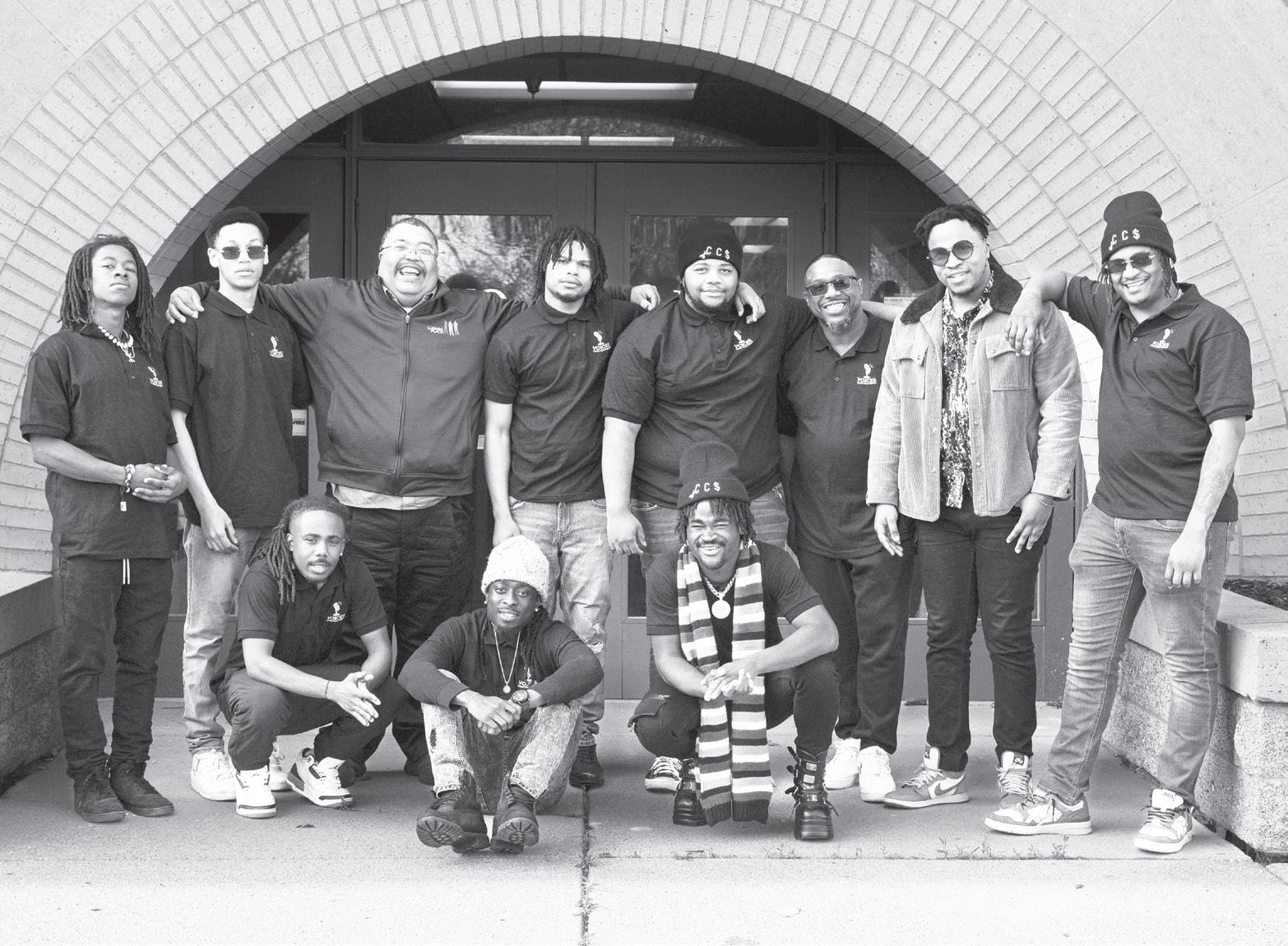
Coaches conduct intake assessments covering criminal justice history, housing status, employment experience, family relationships, and medical needs. Together, they create an Individualized Transformation Plan, setting clear goals for success.
formation plan is designed to empower them to take full responsibility for their futures and the well-being of their families.
A stable living environment is critical to a participant’s success. Many Ujamaa Place participants come from unstable housing situations, such as shelters, encampments, or temporary stays with friends and family. Without stable housing, maintaining employment is nearly impossible.
partners with private landlords to provide single-room occupancy units and assists qualified participants with Section 8 housing through the Twin Cities Housing Development Corporation. Rent subsidies are available until participants secure stable employment and can contribute financially.
gram’s impact is the success of a former participant who in 2022 sought CDL training to improve his employment prospects. After completing the rigorous 180-hour program, he secured a high-paying job with benefits within two weeks, allowing him to provide for his family with the long-term goal of purchasing a home.
This milestone was lifechanging for him, demonstrating the power of economic stability through workforce development and housing security.
Homeownership is a cornerstone of financial stability and generational wealth, particularly for low-income African American families. It has the potential to transform lives, strengthen communities, and close the racial wealth gap. By increasing access to homeownership, society can create longterm economic opportunities and financial independence for African American families.
College, Hallie Q. Brown Community Center, St. Paul YWCA, and Walker West Music Academy. This proximity fosters collaboration and enhances opportunities for participants.
Securing a permanent facility reinforces Ujamaa Place’s commitment to transforming lives through stability and community engagement. In African American communities, property ownership is more than a symbol of success — it is a means of controlling one’s future and building generational wealth.
Homeownership remains one of the most effective tools for economic empowerment, particularly for those historically excluded from financial opportunities. Expanding access to homeownership, coupled with supportive policies and community-driven programs, is essential in reducing racial economic disparities and creating sustainable change.
Participants receive oneon-one tutoring for GED completion, job skills training, and life skills courses on topics such as responsible fatherhood, financial literacy, healthy relationships, driver’s license acquisition, and managing legal obligations.
Regular support sessions with coaches and peer groups help participants address personal and systemic barriers to success. Mentors guide them through every stage of their transformation, reinforcing progress through community engagement activities, group discussions, and shared meals. Each participant’s trans-
Ujamaa Place’s housing program, in collaboration with its housing partners, ensures that all enrolled men have access to safe and secure accommodations. The organization’s Housing Support and Services Programming addresses the homelessness-incarceration cycle by offering immediate shelter upon enrollment.
Participants are provided with or referred to safe housing options, clean clothing, personal hygiene supplies, and two daily meals. Housing options range from emergency shelters to single-room occupancies, independent units, and even homeownership opportunities.
Participants transition from emergency shelters to shortterm and long-term supportive housing before securing permanent housing through agencies such as Saint Paul Public Housing. Ujamaa Place
Even after participants achieve success in stable housing, education and employment, Ujamaa Place maintains relationships with alumni, encouraging them to return, share their experiences, and support new enrollees.
A testament to the pro-
Ujamaa Place embodies this principle. Under the leadership of the late CEO Chris Crutchfield, the organization secured a permanent home — a 17,000-square-foot headquarters at 490 Concordia Ave. in Rondo, St. Paul’s historic African American community. This facility symbolizes stability, growth, and the empowerment of the men Ujamaa Place serves.
The new headquarters is strategically located near key community partners, including the Martin Luther King Recreation Center, Saint Paul
By continuing its mission to support African American men in overcoming systemic barriers, Ujamaa Place is not just changing individual lives — it is shaping a more just and equitable society.
Ujamaa Place opened its doors in 2010 with the mission of helping participants achieve brotherhood, stability, and personal success. For more information, visit ujamaaplace.org.
Francine Carter is the Advancement Associate for Ujamaa Place.
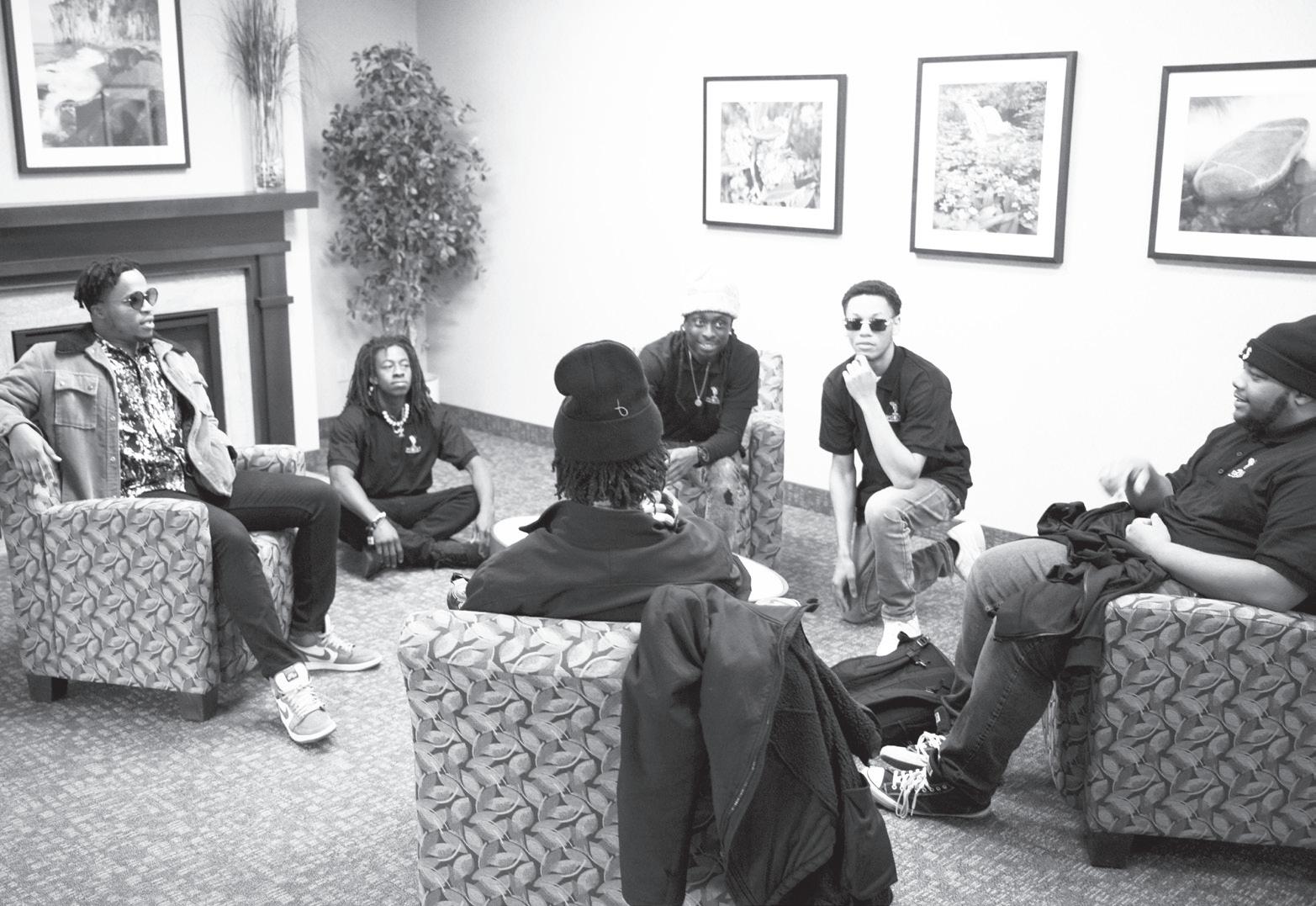
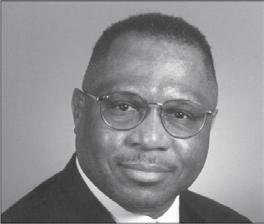


Bobby Joe Champion is a vilified hero
By Rev. Alfred Babington-Johnson
In 2020, a policeman was videotaped crushing the life out of George Floyd while fellow officers stood by. The horror of that experience ushered in a season marked by a determination to address untreated wrongs.
In 2025, the pendulum of community consciousness has now swung in a new and dangerous direction. Lies, distortions, and grotesque political manipulations dominate our times. We will push through to the other side of this midnight only if we find our voices and stand against the darkness.
For this cause, I must express my outrage at the vilification faced by an African American community hero. A public servant and source of pride is now being attacked for the very characteristics that led his village to recognize him as heroic.
Bobby Joe Champion, born on the North Side of Minneapolis, completed his education at Macalester College and earned a Juris Doctorate from William Mitchell. He worked with local legends like Terry Lewis and Jimmy Jam, enjoying a successful private career before he felt a call to public service.
After two terms as state representative, he was elected to the Senate, where his colleagues deemed him a leader deserving of elevation to president of the Senate. This is an elected official engaging issues
and processes to ensure the government acts as an ally to the people. He also dedicates time and energy as a volunteer in community events, as a probono lawyer for individuals and agencies, and as a mentor and friend to those in need. Now, he is unjustly attacked for his efforts to serve the community by those who see a moment of political advantage and exploitation. A recent headline, which we in the community know to be false and biased, illustrates this point: “DFL Senate president steered millions in public funds to a legal client.”
“His efforts have benefited the entire state of Minnesota.”
This is an inflammatory misrepresentation that occurs during a critical season in which approaches to addressing the violence of our times are being discussed.
Bobby Joe Champion, Esq. is a well-respected legal practitioner. He generously provides counsel and pro-bono services to individuals and agencies in our village and beyond. His efforts have benefited the entire state of Minnesota, allowing segments of society that are often overlooked to better serve their missions because the senator works to provide resources so they can continue good works.

By Joel A. Novak
The Minnesota criminal justice system was created in 1857. There were 42 attorneys in the State. Lawyers just practiced “law” — every kind of law. Today, the Minnesota Bar recognizes 11 specialties. A lawyer can be good at two, three, maybe four different kinds of law; however, the one thing I can guarantee you is: If a lawyer says they practice all kinds of law, they engage in malpractice every day.
only defense counsel before they became judges. Imagine facing this if you were the victim of a terrible crime. Only 14% of judges are highly experienced, and had the appearance of being neutral and detached. Only 1% had any appellate experience. Only .003% had legal education above the basic J.D.
tury. We need a constitutional amendment and statutory changes that bring experience into both the criminal bar and bench. We need advancement based on merit and the choices of the People’s legislators rather than the appointment of governors’ friends.
This is not just a Minnesota problem. States are realizing their systems were built for 150 years ago.
submissions@spokesman-recorder.com
submissions@spokesman-recorder.com
ads@spokesman-recorder.com
submissions@spokesman-recorder.com.
I have known Senator Champion for over 40 years. He is a man of integrity and a servant determined to empower those typically left on the margins. Contrary to the facts, some reporters, unwilling to be objective conveyors of facts and seekers of truth, produced the misleading headline mentioned earlier.
Too many of our inner-city neighborhoods are plagued by violence and drug trafficking, which diminish the quality of life. The African American community has come to understand that solutions cannot be expected from outside to address these crises.
One important indigenous response is 21 Days of Peace. This is an intentional effort to rebuild relationships between the community and the police. 21 Days, led by Rev. Jerry McAfee, has garnered applause from both the police and affected neighborhoods because it has proven effective in building bridges with law enforcement and empowering neighborhoods to reclaim their spaces.
Regrettably, personality clashes between the program leadership and certain city council members escalated and became the main issue, overshadowing the essential community service being provided. Senator Champion, concerned about preserving the progress made in the neighborhoods he represents, attempted to redirect attention towards effective service instead of personal disputes.
What followed was a press eager for sensational headlines and politicians sensing an opportunity for disruption. We need better.
Senator Champion has lived in the North Side of Minneapolis his entire life. Isn’t it a cause for celebration that he has built strong relationships with the people and agencies in his village? Shouldn’t we celebrate his volunteer commitment and the fact that he has firsthand information about the effective providers of services?
Would we criticize former President Jimmy Carter for working with Habitat for Humanity and then finding opportunities to bring financial support to their good work? Before he held office, Bobby Joe Champion worked in the Stairstep Foundation’s community-building programs. We recognized his intelligence, energy and dedication. Although over 20 years have passed since working at Stairstep, we continue to share a passion for community advancement.
During his public service,
78% of Minnesota cases are criminal cases. We have 283 trial judges in the state. 39% had experience only as a prosecutor before they became a judge. Imagine being an innocent defendant facing such a judge. 34% never tried a criminal case before they became judges.
Imagine if you are an innocent defendant, or the victim of a terrible crime. 18% were
This is not just a Minnesota problem. States are realizing their systems were built for 150 years ago. They are splitting their civil and criminal courts; their intermediate appellate courts; and ensuring their supreme courts have a mix of civil and criminal experience. It is time for Minnesota to move into the 21st cen-
The People deserve the best protectors. The accused deserve the best defense. The accused, the victim, and the People deserve highly experienced, impartial referees.
Joel A. Novak, LL.M. has served as a prosecutor, public defender, government appellate attorney, commissioner on appellate court, and as a chief prosecutor.
In MN prisons, ‘chaos and ignorance is king’
By Alonzo Graham
What is prison for? Rehabilitation? Revenge? To make millions for private corporations with ties to Department of Corrections (DOC) employees and politicians? Look up the whistle blower from MINCORR Industries, a private company under contract with the MN Department Of Corrections, secretly recording MINCORR employees bragging about making $50 million in one year from slave labor! You would expect rehabilitation, but that’s not even a top-5 priority of the DOC.
The DOC is not a rehabilitative system. It is a racket with the perfect cover: “keeping the communities safe from the criminals.” Since the target demographic are perceived as criminals, the public could care less about what goes on in here. Don’t be deceived by the public relations-written speeches, or the confusing number play in the MRRA earned time “policy”; the truth is “US” the incarcerated.
The programs that the DOC offers are one size fits all, standard and arbitrary. A college degree is the number-one program for reducing recidivism, but the average timeframe for incarcerated individuals to even get an AA degree has been 9 years! This is due to the limited classes made available, often repeating the exact same class back-to-back, though a new program at Stillwater is actually getting it done in two years.
Around 2018-19, Commissioner Schnell “ordered” close custody prisons (level-4/maximum) to begin the process of transitioning their facilities to single (1-man) cells. Stillwater was first to comply, but MCFSt. Cloud, and MCF-Rush City have not even attempted to try.
Overcrowding is a real human rights and civil rights issue. The violence that takes place due to double cells is major, and it makes prison very unsafe for all of us. Cellmates have
killed, beat to a pulp, paralyzed, caused brain damage, stabbed, sexually assaulted and sexually harassed cellmates.
I’m currently helping a few inmates with their own civil rights suits. Hopefully we get enough for a class action. One individual, Armond Stewart, was attacked while sleeping, sending him to the hospital, leaving Stewart with constant headaches, loss of vision in left eye, loss of sleep and paranoia about it happening again. The correctional officer who discovered Stewart getting beat in a pool of his own blood refused to intervene to stop the assault. Another individual named Eli B. Lange was sleeping when his cellmate bashed him in the head with a hot pot, causing significant damage, sending him to the hospital. Lange’s cellmate told the correctional officer to move him out of the cell earlier that day due to a conflict between him and Lange that was escalating. The guard refused to move one of them, and that night as Lange slept, he was brutally attacked.
tinuously prolonging us getting the phone function on our tablets shows their mindset towards our safety. As commissioner Paul Schnell said, 80% of fights in Rush City are over the phones. Riots are common; we just had an inmate stabbed in the head over the phone, and fights happen on a consistent basis.
The DOC staff are not worried about ending the violence — it’s their bread and butter. They try to use the excuse of not being able to stop someone from using their cellmate’s phone while serving loss of privileges punishment. So basically the chance that we will violate a “minor infraction” is more important than the often extreme violence committed over the phones?
Does this make sense? It does to the DOC. Violence is the Department of Corrections. Why would they want to reduce the only thing that validates their relevance and lines their pockets?
Don’t be fooled. Listen when we reach for help — you’d be surprised about what goes on
The violence that takes place due to double cells is major, and it makes prison very unsafe for all of us.
Quinten L. Osgood JR. was attacked on flag time out of cells by two inmates for close to 10 minutes and the guards didn’t see or hear it. This has caused him to have panic attacks, insomnia and paranoia.
Pierre Ramsey was viciously stabbed while being chased around the unit. He ran to the officers desk begging for help and the officers literally said they were “not trying to get stabbed too,” letting the inmate get stabbed around 7 times while they waited for the squad. Pierre had to run into someone else’s cell for safety.
DOC staff could care less about our safety or well-being.
This is a FACT!
The fact that they are con-
we have seen support for the Latino Chamber of Commerce, Hmong American Partnership, Southern MN Initiative Foundation, Iron Range Resources & Rehabilitation Board, and others. I am sure we are all very grateful for his commitment to service and that he finds our activities worthy of his support.
in here. Any reasonable person would have an issue with the way the MN Department of Corrections is being run. A lack of accountability has bred an environment of corruption and exploitation, all at the expense of our wellbeing. We are not political pawns, slaves or chattel, but that is what we are being used for. We are all trying to survive and become better in a place where chaos and ignorance is king and the facilities themselves are perpetuating it. How can we grow in a place where growth is met with the most resistance?
Alonzo Graham is an inmate at Rush City.
From Ads Department/MN Spokesman-Recorder
INVITATION TO BID
PHONE: 612-827-4021
FOR BILLING INQUIRIES & TEARSHEETS
their questions to Dr. Little by 4/25/2025. All bids must be submitted no later than 3PM due on 5/2/2025.
All bids should be delivered to the school district via email to joan@cpathmn.org and be clearly marked: Vended School Meals Bid. Minnesota Spokesman-Recorder April 17, 24, 2025
TECHNICAL BUSINESS ANALYST
IT Company (Minnetonka, MN) seeks Technical Business Analyst to prepare business cases, business requirement documents, user story documents, functional and technical specification documents, requirement traceability, test plans, test scripts and software development plans. Conduct GAP analysis, Workflow Analysis, Data Mapping, Scrum Methodology and Business Process Mapping. Maintain financial and business systems internal control practices and procedures by using project management tools such as JIRA, SMEs Microsoft Office, Confluence, HP Application, Lifecycle Management and SharePoint. Offered salary:$122,916.00 to $123,000.00/year. Send resumes to: HRD, Maritz Consulting (d/b/a Ledelsea), 12800 Whitewater Drive, Suite 40, Minnetonka, MN 55343 Minnesota Spokesman-Recorder April 17, 2025

Continued from page 12
“I always tell everybody I relived the game and finding joy in [watching] little kids running around the field. It made me remember myself at the age of 10, 12 playing in the outfield, just trying to throw the ball to first base and get kids out.”
Speas, a Georgia native, signed with the Twins on a minor league contract last November, his sixth MLB organization (Texas, 201623; Oakland, 2020; Chicago White Sox, 2024; Houston,2024; and Boston, 2024).
The 6’3” righthander made his MLB debut in July 2023 with the Rangers and stuck around long enough to earn a World Series ring at season’s end.
Bouncing back and forth between the minors and the majors has been frustrating for Speas, who says his love of baseball has fully returned.
“I will say God has blessed me with a great fastball, being able to get up into triple digits. God gave me the blessing to throw 100 miles per hour,”


stated Speas, who missed time from 2018-19 after recovering from Tommy John surgery on his right elbow.
“God gave me the blessing to throw 100 miles per hour.”
Last Friday in a Saints win over Omaha the pitcher retired six batters in a row, five on strikeouts that tied his career high in 2 1/3 innings, allowing only a hit. Now he only wants another chance to stick in the majors. It’s important for him for many reasons, said Speas. “I look back into it and the only person in my family to ever play any type of baseball was my great grandfather as a Negro Leagues pitcher. I never ever got to meet him, but being part of something like that would just mean a lot to me, my family, and honestly just being an example to the young African Americans coming up behind us.”
Charles Hallman welcomes reader comments to challman@ spokesman-recorder.com.
No. 24 to honor both Ken Griffey, Jr., and Kobe Bryant, “my two inspirational guys I looked up to,” he admitted.
A/1
Contract No. 26-006
Sealed bids will be received by the Public Housing Agency of the City of Saint Paul at 200 East Arch Street, St. Paul, MN 55130 for BOILER AND AIR HANDLING UNIT REPLACEMENT AT EDGERTON HI-RISE, Contract No. 26-006 until 2:00 PM, Local Time, on MAY 8, 2025, at which time they will be publicly opened and read aloud via the Teams App. Bids may be submitted electronically, in a PDF format, to NorthStar Imaging, www.northstarplanroom. com, or may be delivered as sealed bid to the address above.
PLEASE CONTACT
ACCOUNTING DEPT
A Pre-Bid Conference will be held on Tuesday, APRIL 22, 2025, at 10:00 AM, local time, at EDGERTON Hi-Rise, 1000 EDGERTON., Saint Paul, MN 55102.
BILLING@SPOKESMAN-RECORDER.COM
LEGAL NOTICES
SIZE: 2 COL X 3.5”
A complete set of bid documents is available by contacting NorthStar Imaging at 651-686-0477 or www.northstarplanroom.com, under the public plan room, BOILER AND AIR HANDLING UNIT REPLACEMENT AT EDGERTON HI-RISE, Contract No. 26-006. Digital downloads are no charge. Contact Northstar for hard copy pricing.
RATE $18.10 PCI (1ST RUN)
SUBTOTAL: $ 126.70
RATE: $12.06 PCI (ADDITIONAL RUNS)
SUBTOTAL: $84.42
TOTAL: $211.12
Bids must be accompanied by a 5% bid guarantee, non-collusive affidavit, EEO form and Minnesota Responsible Contractor Compliance Affidavit. The successful bidder will be required to furnish both a satisfactory performance bond and a separate payment bond.
From Ads Department/MN Spokesman-Recorder
PHONE: 612-827-4021
FOR BILLING INQUIRIES & TEARSHEETS
PLEASE CONTACT
ACCOUNTING DEPT
BILLING@SPOKESMAN-RECORDER.COM
LEGAL NOTICES SIZE: 2 COL X 5” RATE $18.10 PCI (1ST RUN) SUBTOTAL: $181.00
Continued from page 12
in Minnesota, Woods Richardson made his first MLB start last April after he began the 2024 season with Triple-A St. Paul, where he made three starts for the Saints. The 24-year-old righthander finished second among all rookies in Twins history in strikeouts-per-9.0 innings pitched, tied for fifth among all rookies in baseball in strikeouts (26), and second among AL rookies in innings pitched.
He wore No. 78 last season, the first player or coach in Twins history to do so, but Woods Richardson this season is now wearing
Among Woods Richardson’s personal goals is one day joining the Black MLB pitchers’ “Black Aces” list — 15 Black pitchers who won at least 20 games in a season. The title is from Mudcat Grant’s book of the same name. Grant (1935-2021) went 21-7 for the Twins in 1965.
“That’s one of my goals,” Woods Richardson said. Woods Richardson last Sunday improved his record to 1-1, going five innings and striking out five in the Twins’ 5-1 win over Detroit.
Charles Hallman welcomes reader comments to challman@ spokesman-recorder.com.
From Display Ad Department/MN Spokesman-Recorder
Please proof, respond with email confirmation to ads@spokesman-recorder.com
The PHA reserves the right to reject any or all bids or to waive any informalities in the bidding.
AN EQUAL
PHONE: 612-827-4021
Please Note: New email address for all future ads is ads@spokesman-recorder.com
STEVE AHNER
OPPORTUNITY AGENCY PROJECT LEADER (651) 248-4807
FOR BILLING INQUIRIES & TEARSHEETS
The MSR handles billing digitally. This means you will get e-tears and e-mailed invoices unless you specifically request a hard copy.
STEVE.AHNER@STPHA.ORG
PLEASE CONTACT ACCOUNTING DEPT billing@spokesman-recorder.com
Minnesota Spokesman-Recorder April 17, 2025
EMPLOYMENT DISPLAY
SIZE: 2 COL X 3 INCHES
RATE $44.60 PER COL. INCH
Paul at 200 East Arch
SUBTOTAL: $267.60
St.
MN 55130 for PLUMBING SERVICES FOR PHA HI-RISES, CONGREGATE SITES AND CENTRAL ADMINISTRATION OFFICES, Contract No. 26-010 until 2:00 PM, Local Time, on Wednesday, May 7, 2025, at which time
+ TWO WEEKS ONLINE: $300
TOTAL: $567.60
and read aloud via the Teams App. Proposals may be
electronically, in a PDF format, to Northstar Imaging, www.northstarplanroom.com , or
delivered to the address above.
Please proof, respond with email confirmation to ads @spokesman-recorder.com.
A Pre-Bid Conference will be held on Wednesday, April 24, 2025, at 10:00 AM, at Mt Airy Hi-Rise Community Room, 200 East Arch Street, St. Paul, MN 55130. Immediately following the conference there will be question period for prospective bidders. All questions arising from this pre-bid conference will be addressed by addendum if necessary.
Possible Publication dates between the request time frame are March 21, 2024 or March 28, 2024
A complete set of bid documents is available by contacting Northstar Imaging at 651-686-0477 or www.northstarplanroom.com, under public plan room, PLUMBING SERVICES FOR PHA HI-RISES, CONGREGATE SITES AND CENTRAL ADMINISTRATION OFFICES, Contract No. 26-010. Digital downloads are available at no charge. Contact Northstar for hard copy pricing.
The MSR handles billing digitally. This means you will get e-tears and e-mailed invoices unless you specifically request a hard copy.
Bids must be accompanied by a 5% bid guarantee, non-collusive affidavit, EEO form and Minnesota Responsible Contractor Compliance Affidavit. The successful bidder will be required to furnish both a satisfactory performance bond and a separate payment bond.
The PHA reserves the right to reject any or all bids or to waive any informalities in the bidding.
Please proof, respond with email confirmation ads@spokesman-recorder.com
Please Note: New email address for all future ads is ads@spokesman-recorder.com
The MSR handles billing digitally. This means you will get e-tears and e-mailed invoices unless you specifically request a copy.

Continued from page 12
(Minnesota Golden Gophers vs. the Florida Gators).
Senior guard Paige Bueckers (Hopkins) closed her career scoring 17 points to lead the Huskies 82-59 past the Gamecocks, who got 10 points from sophomore guard Tessa Johnson (St. Michael Albertville).
Continued from page 12
and Quincy Lewis to name a few. And of course, Coach Haskins, who at one time was the school’s all-time winningest coach before his record was readjusted due to NCAA sanctions.
But nothing happened to North Carolina, who during an investigation that began in 2010 was found creating “sham” classes and giving out high grades to athletes and non-athletes and was put on a year’s probation. But after an NCAA investigation was conducted, UNC was not punished as was the case in Minnesota, and no records were deleted as a result.
Life went on at Chapel Hill. The same should occur in
In the WBIT championship contest, freshman guard Tori McKinney (Minnetonka) finished with 14 points and junior backcourt mate Amaya Battle (Hopkins) added 10, leading to a 66-52 Gophers victory over the Gators. Freshman guard Liv McGill (Hopkins) led Florida with 18 points.
Dr. Mitchell Palmer McDonald welcomes reader comments to mcdeezy05@gmail.com.
Dinkytown.
The 1997 Gophers have been outcasted enough — they have worn sack cloths, and people too often talk about them in hushed tones. It’s time to bring back the banners and photos from that unforgettable and historic season.
“I hope Niko has some influence,” said Shikenjanski. “They should be recognized for what they did on the court, making it to the Final Four.”
“Every single one of those guys is deserving,” concluded Shikenjanski. “They gave blood, sweat and tears to the university. People say they’re deserving.”
Black-coached tennis
Four Big Ten schools in separate sports competed
Please proof, respond with email confirmation ads@spokesman-recorder.com
Please Note: New email address for all future ads is ads@spokesman-recorder.com
The MSR handles billing digitally. This means you will get e-tears and e-mailed invoices unless you specifically request a copy.

AN EQUAL Jim Rooney OPPORTUNITY AGENCY PROJECT LEADER (651) 248-4807 Jim.Rooney@stpha.org Minnesota Spokesman-Recorder April 17, 2025 From Ads Department/MN Spokesman-Recorder PHONE: 612-827-4021 FOR BILLING INQUIRIES & TEARSHEETS PLEASE CONTACT ACCOUNTING DEPT BILLING@SPOKESMAN-RECORDER.COM
significant things happen for us.”
Continued from page 12
increased over the course of this season — she played in 34 games, averaged 5.5 minutes a game, and tied Tori McKinney with a team-high 12 blocks.
“Nia gave us a great boost,” said Minnesota Coach Dawn Plitzuweit on Holloway. “I think she’s made some really
“She’s a hustle player,” noted Holloway’s mother Nolana of Niamya, one of her four children. “What she does on the floor doesn’t go on the books, but it makes a difference in the game, and that’s what matters to me.”
Charles Hallman welcomes reader comments to challman@ spokesman-recorder.com.
against each other last weekend. All four teams were led by Black head coaches.
“Every single one of those guys is deserving.”
Illinois, coached by Tyra Perry, hosted Michigan State, coached by Sharonda McDonald-Kelley in a threegame weekend softball series. Minnesota hosted Indiana in women’s tennis last Friday, coached by Lois Arterberry (Gophers) and Gabrielle Moore (Indiana). The MSR attended the match and will file a report in next week’s edition.
Sistahs out in front During ESPN’s coverage
of Monday’s WNBA Draft, sistahs were out in front. Andraya Carter and Chiney Ogwumike were among the in-studio analysts, and Elle Duncan co-hosted SportsCenter from New York City’s The Shed at Hudson Yards, the site of this year’s three-round draft.
“I think visibility is always important,” said Carter during last Thursday’s pre-draft media Zoom media call in response to an MSR question on the Black women’s presence. “We constantly say, if you can see her, you can be her. So, to see someone that looks like you, if you’re a young girl, I think that’s always important.”
Charles Hallman welcomes reader comments to challman@ spokesman-recorder.com.
U.S.-born Black players on Major League Baseball rosters are barely 6% of this season’s opening day ros-
ters. The 2025 Minnesota Twins have three Black players and a Black coach. The organization also has two Black pitchers, Alex Speas and Simeon Woods Richardson. Last week we talked to both in separate interviews.
lex Speas a few years ago took a break from playing pro baseball.
The St. Paul Saints’ only Black pitcher vividly recalls why as we sat in the dugout at the team’s St. Paul Lowertown ballpark.
“Going back into 2020, Covid and 2021, I think that was one of those years for me that baseball just wasn’t fun,” said Speas. “Felt more like a job than a game, or more like a job that should be fun, and I struggled.”

So, at age 21, Speas retired from the game — he was a 2016 second-round pick by Texas. He briefly took a corporate job, but that lasted six weeks. As a result, he
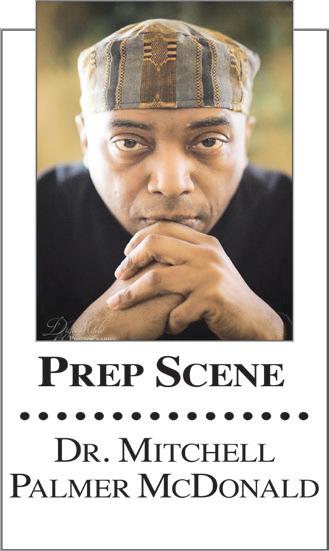
his week’s Fab Five photos feature five former metro girls basketball standouts competing in the NCAA Women’s Division I championship (Connecticut Huskies vs. the South Carolina Gamecocks) and the Women’s Basketball Invitational Tournament (WBIT) championship


fter attending Minnesota at USC earlier this past season, I was totally impressed with a large showing of Blacks in attendance. Never in my five decades-plus of covering the women Gophers have I seen more than small pockets of Blacks, most of them players’ parents, at games in The Barn.
Junior Amaya Battle (Hopkins), freshman Tori McKinney and soph Taylor Woodson (Minnetonka), redshirt frosh Kennedy Klick (Brooklyn Park) and Eden Prairie redshirt soph Niamya Holloway are locally grown Black Minnesotans, plus graduate student Alexsia Rose for a total of six Blacks on this year’s 15-player roster.
“Maybe we need to go to the Final Four and they’ll start
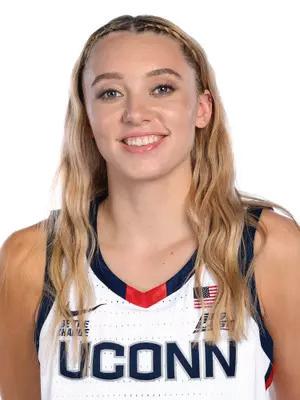



or several years now, each MLB player has their own “walk-up” music when they come up to bat. Pitchers also have their own music when they come to the mound.
Simeon Woods Richardson’s walk-in music is Prince’s “When Doves Cry.”
“We’re in
“I had that thing coming up on a little iPod my cousin
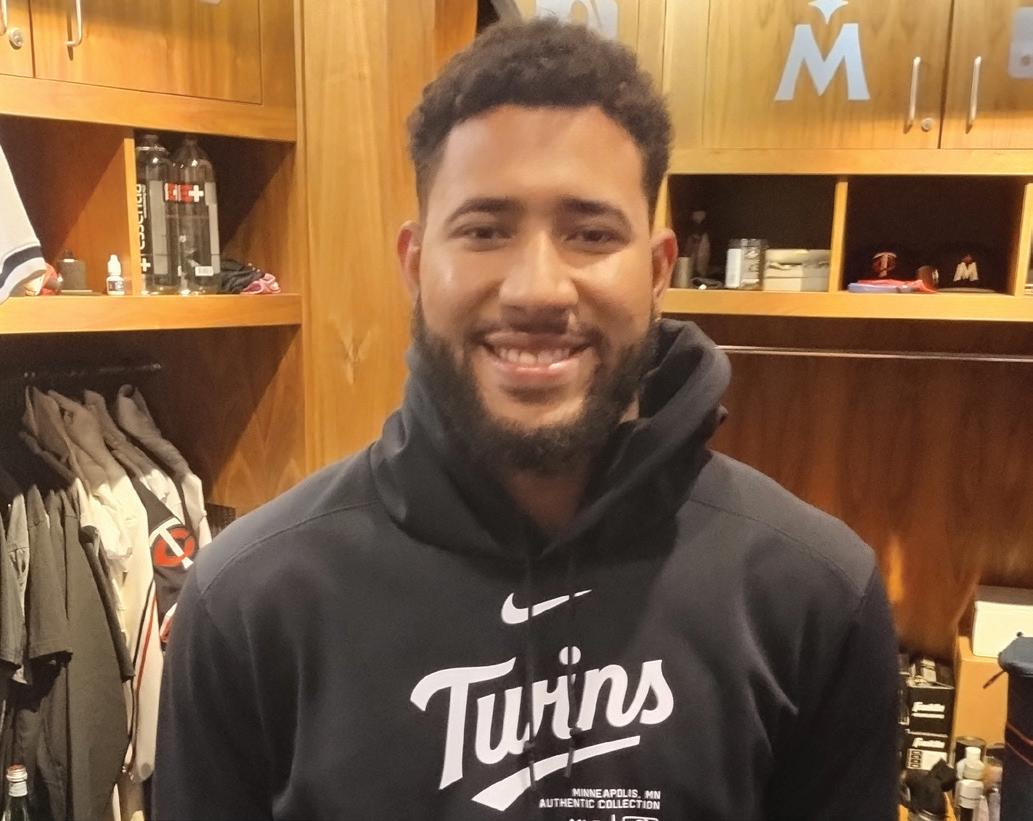
By Charles Hallman Sports Columnist
he MSR for several years has pushed for the University of Minnesota to restore the 1997 Gophers men’s basketball team’s records and accomplishments.
Recently, a Minnesota Star Tribune columnist wrote that now with the hiring of new Head Coach Niko Medved, a student manager on that 1997 team, the school’s only Final Four team should be seriously reconsidered by school officials.
It’s been over three decades since Minnesota was found guilty of academic misconduct, and the NCAA ruled all records by then-coach Clem Haskins and his players at the time be scrubbed from the record books.
Times have changed, added the Strib columnist, who urges the new U of M coach to use his influence to formally recognize the 1997 team, which many of us still call one of the school’s greatest teams ever.
“That team should be rec-
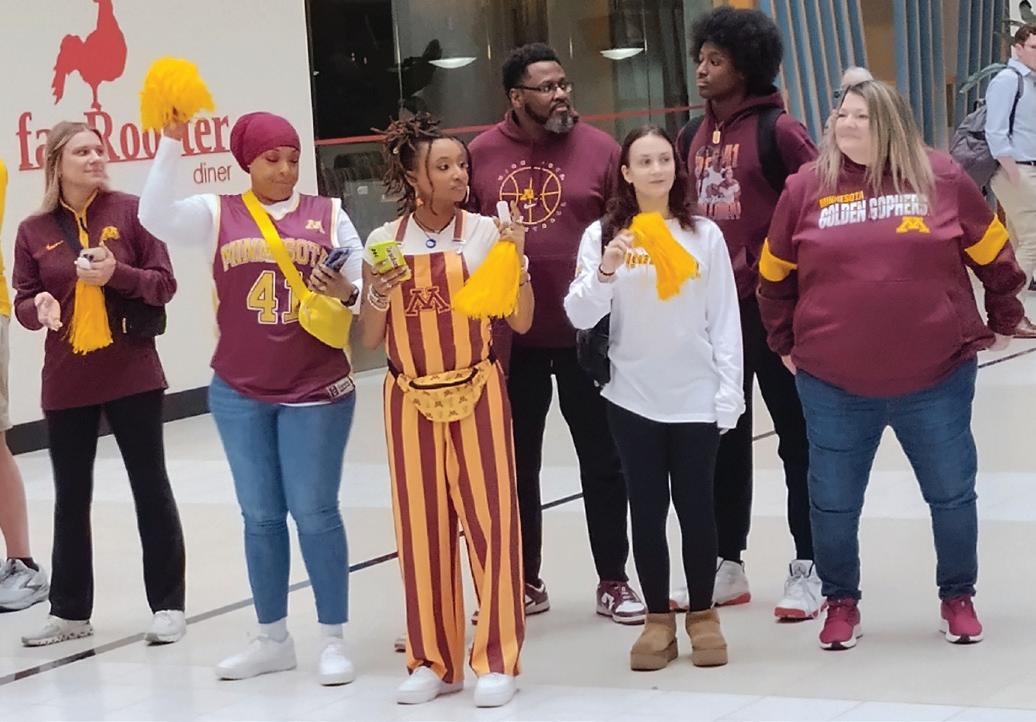
showing up,” said Terrell Battle jokingly. His daughter is Amaya. The Gophers finished 2511 and won this year’s WBIT championship, the only Big Ten school to win a title this season. McKinney won MVP — she and Battle made the alltourney team. They finished WNIT runners-up a year ago. But to argue Mr. Battle’s point, Black fans don’t show
up even when the team makes historic runs, such as Minnesota’s 2004 Final Four run, or its 2003 Sweet 16 finish.
“My daughter grew up watching Rachel Banham and Amanda Zahui B., and that was huge for her,” recalled Nolana Holloway, Niamya’s mom. Banham and Zahui B. both were top WNBA draft picks and Gopher stars.
“All were very big for her to want to continue the legacy of being a Gopher,” added Nolana on a legacy that first began with St. Paul native Linda Roberts back in the 70s. Roberts is the first Black female to have her jersey hanging in The Barn’s rafters.

ognized,” Jim Shikenjanski recently told me. He was a four-year member (198790) on Haskins’ first Gopher team — his team reached the Elite Eight in 1990. That feat still remains in Gopher record books.
“I’m all for trying to get as many banners in Williams Arena as we can,” Shikenjanski said. The ’97 squad “is one of
the greatest teams in the history of Gopher men’s basketball.”
“When you look at the players on that team,” continued Shikenjanski, “there’s some phenomenal talent. Some of the best players, and they should be recognized for that.” Bobby Jackson, Eric Harris, Sam Jacobson, John Thomas, ■ See RESTORING on page 11
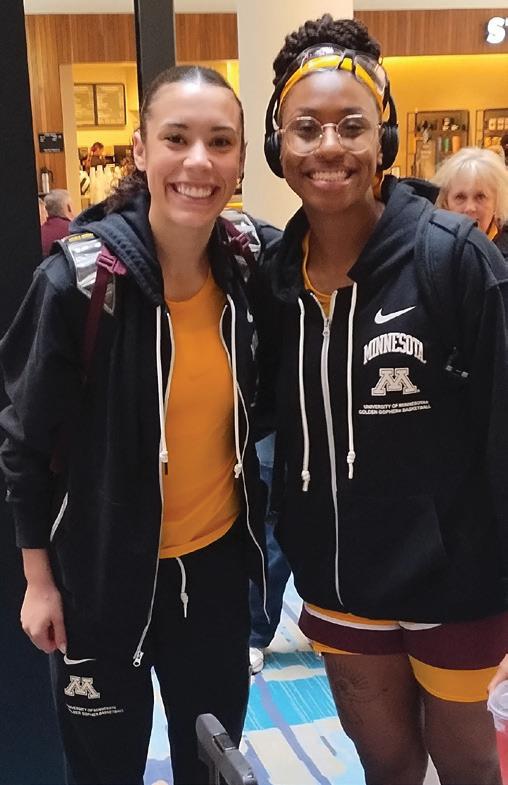
“I think as we continue to have our Black and brown girls be successful in the sport, I think it is going to bring more fan base coming around,” continued Niamya’s mother. “A lot of our [Black] girls go elsewhere, and so it’s good to see our girls staying home for girls to be able to watch.” Sadly, too many good to very good Black female prep players opted for other schools than Minnesota.
“A lot of our Black girls go elsewhere, and so it’s good to see our girls staying home for girls to be able to watch.”
“As a university,” stressed Minnesota Sr. Associate Athletics Director Peyton Owens III, “we need to do more outreach and more engagement” at city schools and other community locations, I think we need
outside the box and go further than just our immediate fan base and those that do have tickets and are involved with our program at the current moment.”
Then how do you increase Black attendance at Gopher women’s basketball games?
“I think it’s, in some cases, Black parents just don’t take the time to bring their children to games,” said Terrell Battle. “If we get the young girls [to] come watch them play, I think it’ll just be a trickle [down] effect.
“I think that’s what we have to work on, getting some of the schools that have predominantly Black populations.” Finally…